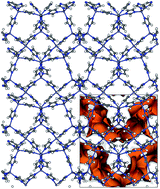The materials genome in action: identifying the performance limits for methane storage†
Abstract
Analogous to the way the Human Genome Project advanced an array of biological sciences by mapping the human genome, the Materials Genome Initiative aims to enhance our understanding of the fundamentals of materials science by providing the information we need to accelerate the development of new materials. This approach is particularly applicable to recently developed classes of nanoporous materials, such as metal–organic frameworks (MOFs), which are synthesized from a limited set of molecular building blocks that can be combined to generate a very large number of different structures. In this Perspective, we illustrate how a materials genome approach can be used to search for high-performance adsorbent materials to store natural gas in a vehicular fuel tank. Drawing upon recent reports of large databases of existing and predicted nanoporous materials generated in silico, we have collected and compared on a consistent basis the methane uptake in over 650 000 materials based on the results of molecular simulation. The data that we have collected provide candidate structures for synthesis, reveal relationships between structural characteristics and performance, and suggest that it may be difficult to reach the current Advanced Research Project Agency-Energy (ARPA-E) target for natural gas storage.


 Please wait while we load your content...
Please wait while we load your content...